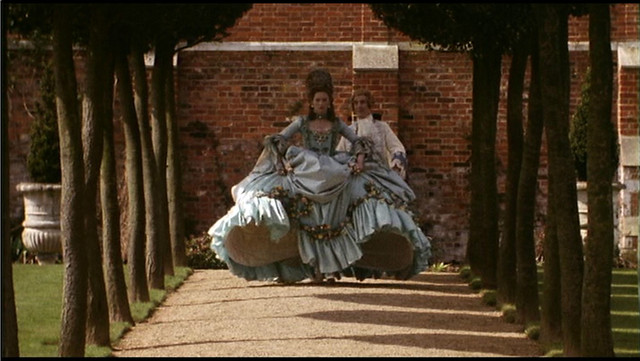
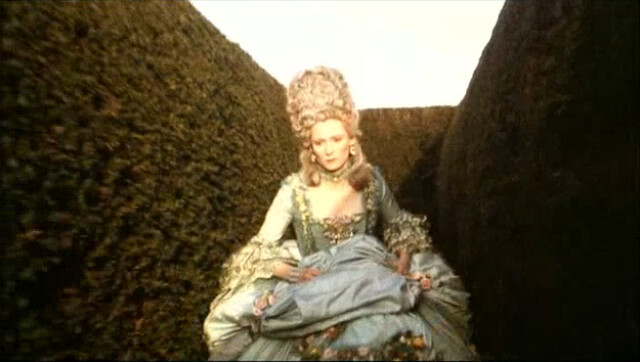
Two films I've watched this summer have been Orlando (1992) and The Portrait of a Lady (1996). Both are period dramas, directed by women, with only four years between their respective releases. Two scenes in particular, from both films, captured my imagination, as well as the costumes. Clothing for characters, as for us, reveals much about class, background and personality. Costume tells us much about the role of women in society, and for both genders, it reveals to us their social background. I don't pretend to possess anything beyond a superficial knowledge of nineteenth-century costume, but reading costume provides a richer history of a particular period, and the nineteenth-century into the twentieth-century was one of tremendous societal change, one that is most explicitly obvious though women's dress. In Orlando, they wear the large petticoats of the mid-Victorian period, whereas in The Portrait of a Lady, her skirts are much more suitable for a young woman travelling, but nonetheless long and cumbersome. What these costumes express is how women were bound to societal gender roles by corsets and impractical oversized or long, heavy layers of skirts and petticoats, representing a very particular ideal of femininity.
Both films feature tackle the subject of gender, with two strong female leads. The gloomy, almost Gothic mood of these films appeals to me, as we tend to associate this moodiness with the Byronic hero, this idea is subverted here. The moody psychic landscapes reflect in tone and feeling, the darker oppressive clothing of the characters. The fog of evening lingers over both scenes as these characters come to make the choice that will determine their lives going forward, and perhaps lead to the fog of uncertainty being lifted.
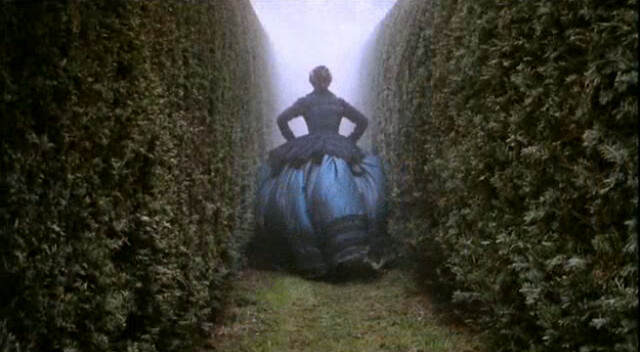
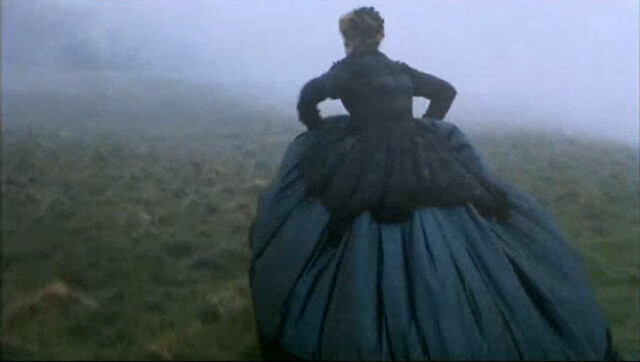
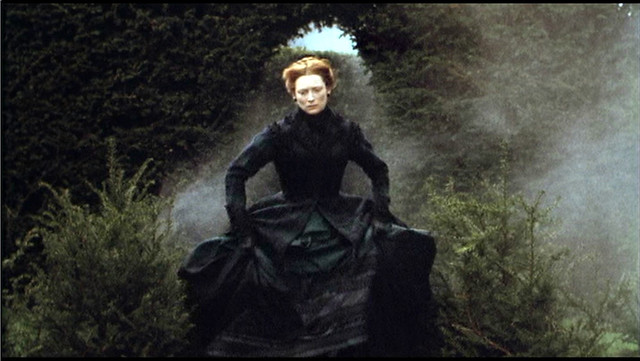
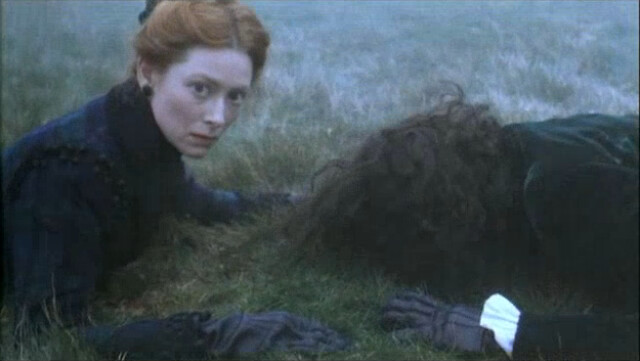
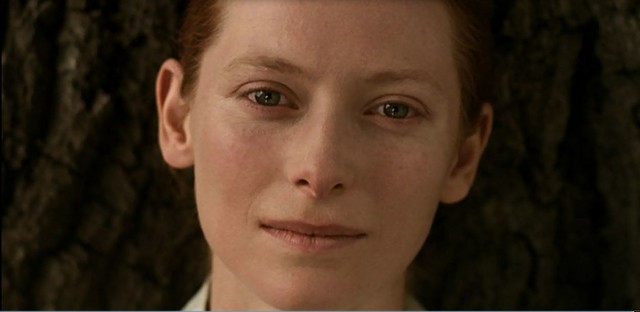
Orlando, 1992 (dir: Sally Potter) is adapted from Virginia Woolf's 1928 novel Orlando: A Biography. The costumes are by Sandy Powell (Shakespeare in Love, Interview with the Vampire). Tilda Swinton, plays the title role of the androgynous young nobleman Orlando. Orlando, the Queen's favourite, is demanded by Queen Elizabeth to remain forever young, and incredibly they do just that, living from decade to decade seeking love, poetry and ultimately the meaning of life. At one point Orlando changes gender, and the revelations that accompany this are aptly played out on screen. Our hero, turned heroine finds themselves (I will refer to Orlando in non gender specific terms) trapped between the intrigue and over-sized crinolines of 18th-century court life, with its egotistical poets and gossips, and salacious men. Alexander Pope informs the now Lady Orlando:
“Conversation, is a place where one plays with ideas, my dear lady, though one forges them quite alone. The intellect is a solitary place and therefore quite unsuitable a terrain for females, who must discover their natures through the guidance of a father or husband.”
When a former acquaintance asks for their hand, Orlando's aghast refusal, reveals to them the imbalance of power between the genders. In this standout scene (see below), Orlando recoils with their dignity intact, but struggles to exit the scene as swiftly as they would like, their silk skirts weighing them down and their perspective all astray. The scene is strongly charged, as our hero/ine struggles through the metaphorical labyrinth of the grand maze, just as they struggle through womanhood, before stumbling on the next period in their development as a woman - 'Sex', represented by the dashing figure of Billy Zane.
Formal or picturesque garden design was the height of fashion in England during the eighteenth century, as in most fashionable matters, England took its cue from the magnificent gardens of the French court. Orlando was filmed at Hatfield House and Blenheim Palace, and it appears that the 'labyrinth scene' was filmed in Blenheim Palace's Marlborough Maze ("the world's second largest symbolic hedge maze").
The Labyrinth scene from 'Orlando'
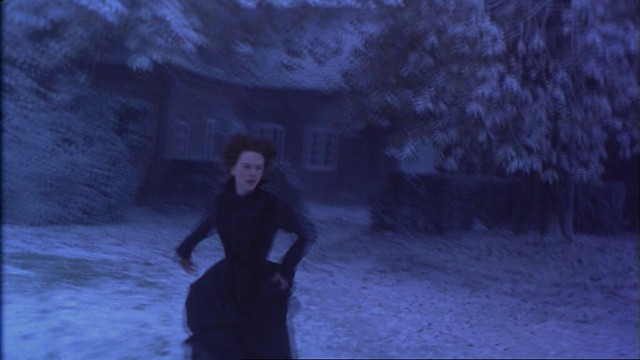
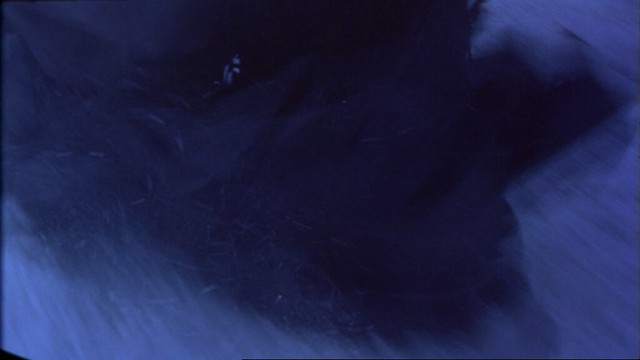

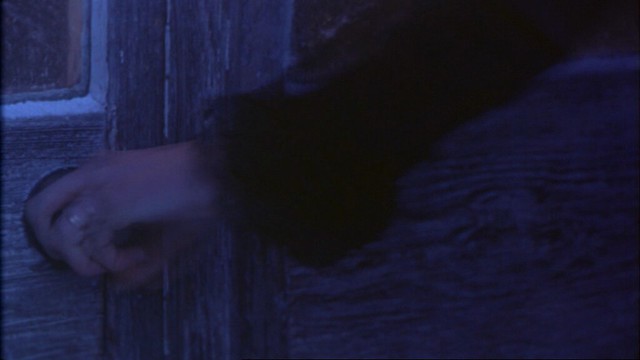
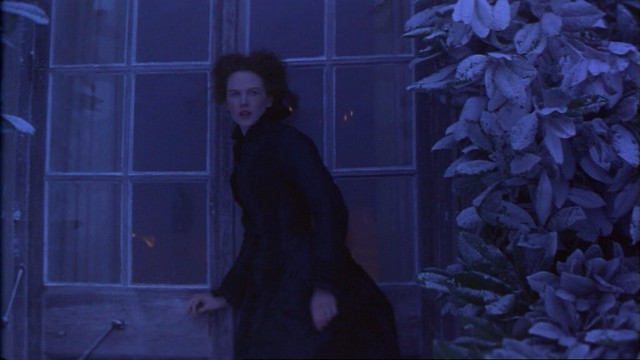
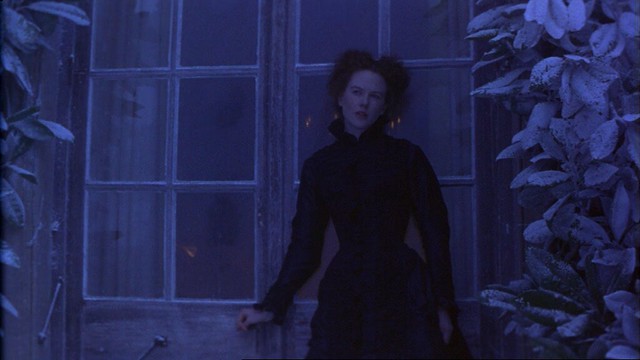
The Portrait of a Lady (1996) (dir: Jane Campion) is adapted from American author Henry James' 1881 novel. The costume designer was Janet Patterson (Bright Star, The Piano). Our heroine is Isabel Archer, a young American heiress, who has come to England to visit relatives, and to 'find' herself, with the intention of embarking on her own Grand Tour. Being an educated young woman, from a good background, she is highly eligible and sought after. Isabel refuses the advances of her young suitors and quickly departs to Italy, where she makes some unfortunate acquaintances and finds herself coerced into a union with the penniless but charming American Gilbert Osmond (John Malkovich, who seems to have excelled at playing dastardly charmers in 90s period films). The film is highly sensual at times, as our young heroine seeks life and love, making naive mistakes along the way. In this final scene, Isabel realises that in order to be her independent self, despite her sexual desires (which women weren't expected to possess), she must be free, and alone to pursue her dreams, for in the role of wife, she would be expected to be the submissive partner in the marital arrangement.
The slowed down frames allow us to observe Isabel more closely as she contemplated her decision (and the deceptive amount of layers to her dress!). She surrenders this final temptation, in order to become herself, truly independent and free. Instead of entering the house as soon as she reaches for the door handle, Isabel turns her body to face our gaze, a contemplative look plays across her face, neither sad or outwardly happy. John Gielgud's character, the aging Mr. Touchett, Isabel's confidante, in a revealing quote on 'self' tells Isabel:
“When you have lived as long as I, you will see that every human being has his shell, and that you must take the shell into account. By the shell I mean the whole envelope of circumstances. There is no such thing as an isolated man or woman; we are each of us made up of a cluster of appurtenances. What do you call one's self? Where does it begin? Where does it end? It overflows into everything that belongs to us - and then flows back again... One's self - for other people - is one's expression of one's self; and one's house, one's clothes, the books one reads, the company one keeps - these things are all expressive.”
In the Victorian period women were expected to be the 'Angel of the House'. Women have to fight for the right to be alone, and were scathingly referred to as 'spinsters', for their seeming inability to catch husbands with their feminine charms (maybe they just didn't have time for that BS eh?), while men often enjoyed bachelor status well into middle age, often then settling down to marry women half their age. Orlando chooses to enjoy sexual relations with another man in the infamously laced up context of the Victorian period. Isabel experiences desire too, but in the strict social conventions of the period, she can only truly enjoy those relations within the confines of marriage. In a marital arrangement, by societal standards of the time certainly, no matter how her husband encouraged her, her husband's needs would come first. Now do you see what I did in the post title, 'No Angel', huh, you get it?
Orlando is also searching for self, becoming accustomed to the restriction of their new female gender. Shocked by a former male acquaintances advances, they rebuff him only to be told that 'she' will end up alone and a spinster. A threat not unfamiliar to many young, unattached young women. In the final scene, Orlando gazes confidently out at us, the viewer, having reached their own revelation.
The characters struggle both metaphorically and physically against their gender roles. You'll notice in the above scenes both directors focus on the weighty quality of the skirts, in their attempts to flee from masculine constraints they are literally weighed down by the clothing and metaphorically by all that it represents in that particular society. Sound also plays a conscious part in the representation of dress in these two films, a subtlety I love and that can only be communicated through the medium of film, unlike a painting alone. Campion's Isabel tinkles delicately as she moves, wearing all the baubles of a heiress, and a lady, a bird in a gilded cage. Potter's Lady Orlando's dress rustles impatiently as it is hitched up and dragged across the earthy ground and against the pruned shrubbery of the maze, in her desperation to escape, troubling with movement is not something Orlando had to contend with as a man.
British and American audiences respectively, have always held a fascination with period dramas, each generation sees a revival of certain popular novels. These two films no doubt presented challenges, as they are both ambitious projects, but are ultimately most satisfying to watch, and yet are still severely underrated. This post was a little meandering, but I hope it will encourage you to watch both of these films (ignore the IMDB ratings in these cases!), and to pay more attention to the beautiful subtleties of dress and costume in film, period or otherwise. Buttons, embellishments, cuts, all have their part to play in the interpretation of a character.

wow wonderful orland 1992 portrail lady picture it was wonderful modeling lovely stylist out fit thanks
ReplyDeletevintage clothing